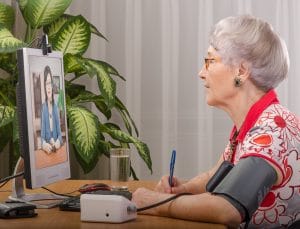This website uses cookies so that we can provide you with the best user experience possible. Cookie information is stored in your browser and performs functions such as recognising you when you return to our website and helping our team to understand which sections of the website you find most interesting and useful.

Susan E. Mazer, Ph.D. Blog
Thoughts and ideas on healthcare
Hi, and welcome to my blog! I'm Susan E. Mazer -- a knowledge expert and thought leader on how the environment of care impacts the patient experience. Topics I write about include safety, satisfaction, hospital noise, nursing, care at the bedside, and much more.
The Patient iExperience Goes Beyond the Hospital
February 17, 2017
 Last week, I wrote about the patient iExperience in the hospital. But what about the patient iExperience beyond the hospital?
Last week, I wrote about the patient iExperience in the hospital. But what about the patient iExperience beyond the hospital?
We live in a digital world. That’s why video conferencing and smart phone apps are poised to become the bridge between personal health and staying healthy.
And, it may be the only way that patients in rural communities can access their primary care provider in their own city or town.
Specialties are also driving the development of mobile applications. For example, The Smart Clinic App helps increase accuracy and compliance with gastroenterology procedures, walking the patient through the prep.
It not only provides information but also gives auditory notifications about the timing of each step. Physician controlled, it’s meant to closely guide patients as they go through the process.
Nonetheless, the larger issue is how to develop a real and lasting relationship between the patient and provider.
Virtual Consultation is Challenging
Forming a therapeutic relationship through a computer monitor or smart phone screen is not easy. As more clinicians begin to do these types of consultations with patients, it presents different challenges in dealing with their stress, fears, and anxieties.
A 2010 literature review of studies on the use of video conferencing between patients and clinicians identified the limits to virtual consultation due to the lack of physical touch. However, overall, patients had a positive experience. The conditions were that the patient was at the point of care, not at home or anywhere else.
A more recent study looked at evaluating patients’ ability to recall their consultation using a video of the physician/patient discussion.
Researchers concluded “VSR (Video Stimulated Recall) may be useful for improving recall, for uncovering cognitive processes and as a tool to facilitate reflections on elements of many different social interactions.” This tool would be valuable especially with older patients whose ability to remember accurately medical directives and processes are compromised.
Clearly, using video conferencing or smart phones to bring clinicians closer to patients can be very effective as long as clinicians know how to use the technology. Stilted discussions due to “stage fright” may make this worse.
Plus, any patient concerns about privacy and confidentiality may prohibit honest exchanges and easy integration of this technology.
Traveling the Large Divide of the Patient iExperience
The leap is not easy.
We use Facetime to talk to our friends, kids, and spouses — not to our physicians. We use our Fitbit for our own workout, not for our medical records.
And, even our smart phones are considered intimately close to us, not to be accessed or used by insurance companies, Medicare, or anyone else.
Regardless, the future is upon us. For deeply personal technologies like this to become real healthcare assets, clinicians will have to build trust with patients. This trust will come slowly and will be tested.
It will come when the personal takes priority over the medical because the time and attention of the patient is both valued and respected — a dramatic change from the long waiting times patients are used to.
It will come when the apps are easy to use, multilingual, and are designed for the benefit and engagement of patients of all ages — personalized to the needs and capacities of the user.
And, it will come when the time spent by physicians, advanced-practice nurses, and other healthcare professionals is fairly compensated and accounted for.
It’s an exciting time to be bringing the patient iExperience to healthcare. And, hopefully, that experience is about being healthy, celebrating increased well-being, and being confident that those to whom patients entrust their health are but a click away.
Bottom line: Healthcare needs to be as provider-effective as it is patient-centered.
P.S. If you like this post, please do me a favor and share on LinkedIn, Twitter, Facebook, etc. Also to get automatic notices when a new post is published, subscribe (upper right). No spam – just great content. Thanks!










